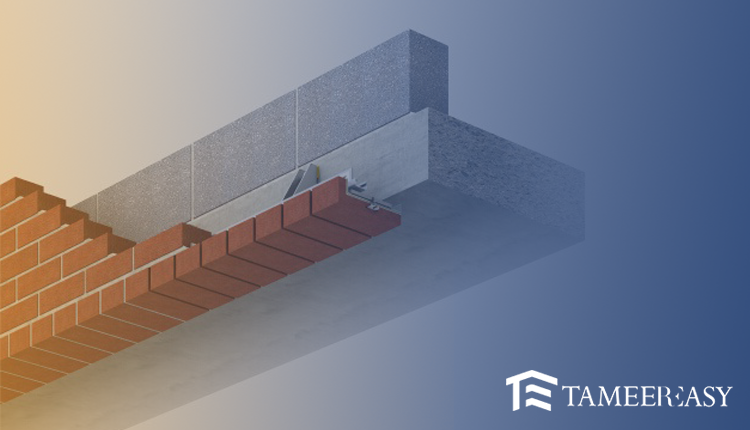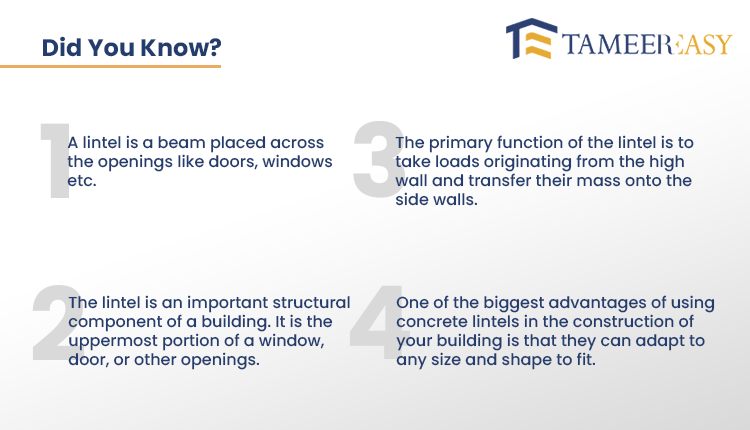Lintels and Projections are extensively used above the windows and doors to protect them from rainy water and other unwanted seasonal changes. Everyone wants to design their houses through Lintels, but it has been seen that they often get eroded by the rainwater, ultimately dislocating them from their original place.
Visit TameerEasy Store to Purchase Quality Construction Items
We are writing this article to show you how you can make these Lintels and Projections strong enough to stay longer and keep protecting your windows and doors. If you want to get all the relevant information about this topic, just scroll down the page.

What are Lintels?
Lintels are the concrete beams used above the openings of windows and doors. The primary purpose of installing the lintels is to protect the under structures. They come in different sizes, which we will discuss in the upcoming section.
Sizes of Lintels
While installing the lintels over the windows and doors, you have to overlap the projection 6 or 9 inches into the walls on both sides. It depends on the wall thickness; if the wall is 9 inches thick, we will overlap the lintel 9 inches and 4.5 inches in the other case.
The window’s opening size plays a crucial role in deciding the size of the lintels. In most cases, a minimum depth of 9 inches is used. Suppose the opening size of the window or door is big. Then, we can even go 12 inches of overlapping into the walls.
How to Make Lintels?
It is quite simple to make the lintels, and we will let you know about the whole procedure. First of all, you must make sure to set the accurate placement of steel. So that they do not touch each other, and spacer blocks are often used to keep them separate. The ideal spacing on the rear side should be 3 or 4 inches. On the sides, it should be around 1.5 inches.
Now comes the time to fill all these spaces with concrete to make a strong bond of steel which will ultimately protect your structures. The ideal ratio of cement to sand to gravel is 1:2:4. If you follow this possess of making concrete, you will get the best strength. The ratio of the mixture is quite crucial and should not be changed. Also, ensure not to mix the sand in it as it can weaken the bonds.


What are Projections?
The projections in houses are mainly used for different designings or giving shelter to doors and windows from the rainwater, commonly known as shades. Sometimes the roofs are extended through these projections. So we can say that they have a lot of benefits and can serve multiple purposes. Projections are made in different designs and shapes, so their making process also varies.
Projections and Different Designs
Although the major parts of projections remain the same in different designs, you have to make a few changes to make the platform per the different shapes. While making the base of the projections, you have to use items differently, like if you are going to make a half-curvature projection shape. Then you can use PVC pipe to get the accurate shape.
How to Make Projections
It is a little bit technical to understand the making process of projections. We at TameerEasy are committed to providing you with easy solutions. So we will be writing the whole process step-wise so you get to know it in an easy manner.
- First of all, you have to make the shuttering per the projections’ design and shape. Now you will get the main platform to use sand or wood straw.
- Projections are usually in the form of Cantilevers. It means that they have more length outside the wall compared to the inside length. So it becomes important to cover ¾ inches at the top while placing the steel.
- If the steel is in a mesh shape means 2 steel lengths of ½ inches, crossing each other, and the shade’s thickness is 4 inches, then the concrete gets the space of 2 ¼ inches which is more than enough for maintaining good strength.
- If the shade is 5 inches, then collectively, concrete gets the space of 3 ¼ inches. So it can form a strong bond with the steel.
Important Note: Steel is placed on the upper side of the Projection while on the lower side in Lintels, beams and slabs.
Few Points to Take Care of in Projections
- The concrete ratio should be perfect, which is 1:2:4.
- While applying the concrete in the projections, always make sure to keep it uniform.
- You can compile concrete using a wooden pestle to fill its empty spaces.
Final Thoughts
So in this article, we have tried to tell you all the information about Lintels and Projections, which could be useful for your house-making projects. You can understand how to make the projections and lintels and what types of precautionary measures you must take while going through this process. If you are still confused and want to know more about this important civil work, you can contact us through our website, tameereasy.com.







